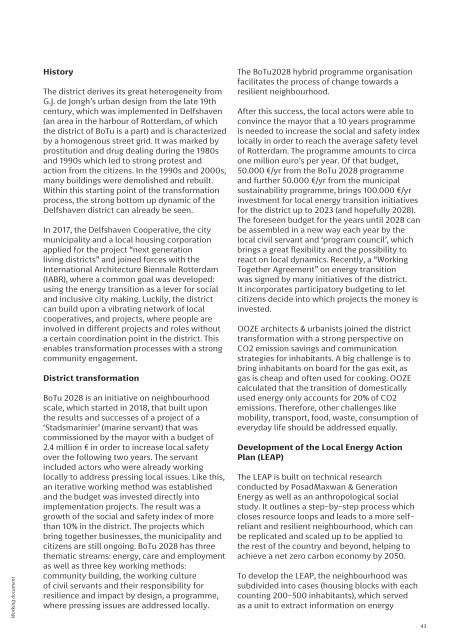Cities4PEDs Atlas_November 2021.pdf
Atlas - From 7 case interviews to recurring strategies and PED relevant aspects
Atlas - From 7 case interviews to recurring strategies and PED relevant aspects
- No tags were found...
You also want an ePaper? Increase the reach of your titles
YUMPU automatically turns print PDFs into web optimized ePapers that Google loves.
Working document<br />
History<br />
The district derives its great heterogeneity from<br />
G.J. de Jongh’s urban design from the late 19th<br />
century, which was implemented in Delfshaven<br />
(an area in the harbour of Rotterdam, of which<br />
the district of BoTu is a part) and is characterized<br />
by a homogenous street grid. It was marked by<br />
prostitution and drug dealing during the 1980s<br />
and 1990s which led to strong protest and<br />
action from the citizens. In the 1990s and 2000s,<br />
many buildings were demolished and rebuilt.<br />
Within this starting point of the transformation<br />
process, the strong bottom up dynamic of the<br />
Delfshaven district can already be seen.<br />
In 2017, the Delfshaven Cooperative, the city<br />
municipality and a local housing corporation<br />
applied for the project “next generation<br />
living districts” and joined forces with the<br />
International Architecture Biennale Rotterdam<br />
(IABR), where a common goal was developed:<br />
using the energy transition as a lever for social<br />
and inclusive city making. Luckily, the district<br />
can build upon a vibrating network of local<br />
cooperatives, and projects, where people are<br />
involved in different projects and roles without<br />
a certain coordination point in the district. This<br />
enables transformation processes with a strong<br />
community engagement.<br />
District transformation<br />
BoTu 2028 is an initiative on neighbourhood<br />
scale, which started in 2018, that built upon<br />
the results and successes of a project of a<br />
‘Stadsmarinier’ (marine servant) that was<br />
commissioned by the mayor with a budget of<br />
2.4 million € in order to increase local safety<br />
over the following two years. The servant<br />
included actors who were already working<br />
locally to address pressing local issues. Like this,<br />
an iterative working method was established<br />
and the budget was invested directly into<br />
implementation projects. The result was a<br />
growth of the social and safety index of more<br />
than 10% in the district. The projects which<br />
bring together businesses, the municipality and<br />
citizens are still ongoing. BoTu 2028 has three<br />
thematic streams: energy, care and employment<br />
as well as three key working methods:<br />
community building, the working culture<br />
of civil servants and their responsibility for<br />
resilience and impact by design, a programme,<br />
where pressing issues are addressed locally.<br />
The BoTu2028 hybrid programme organisation<br />
facilitates the process of change towards a<br />
resilient neighbourhood.<br />
After this success, the local actors were able to<br />
convince the mayor that a 10 years programme<br />
is needed to increase the social and safety index<br />
locally in order to reach the average safety level<br />
of Rotterdam. The programme amounts to circa<br />
one million euro’s per year. Of that budget,<br />
50.000 €/yr from the BoTu 2028 programme<br />
and further 50.000 €/yr from the municipal<br />
sustainability programme, brings 100.000 €/yr<br />
investment for local energy transition initiatives<br />
for the district up to 2023 (and hopefully 2028).<br />
The foreseen budget for the years until 2028 can<br />
be assembled in a new way each year by the<br />
local civil servant and ‘program council’, which<br />
brings a great flexibility and the possibility to<br />
react on local dynamics. Recently, a “Working<br />
Together Agreement” on energy transition<br />
was signed by many initiatives of the district.<br />
It incorporates participatory budgeting to let<br />
citizens decide into which projects the money is<br />
invested.<br />
OOZE architects & urbanists joined the district<br />
transformation with a strong perspective on<br />
CO2 emission savings and communication<br />
strategies for inhabitants. A big challenge is to<br />
bring inhabitants on board for the gas exit, as<br />
gas is cheap and often used for cooking. OOZE<br />
calculated that the transition of domestically<br />
used energy only accounts for 20% of CO2<br />
emissions. Therefore, other challenges like<br />
mobility, transport, food, waste, consumption of<br />
everyday life should be addressed equally.<br />
Development of the Local Energy Action<br />
Plan (LEAP)<br />
The LEAP is built on technical research<br />
conducted by PosadMaxwan & Generation<br />
Energy as well as an anthropological social<br />
study. It outlines a step-by-step process which<br />
closes resource loops and leads to a more selfreliant<br />
and resilient neighbourhood, which can<br />
be replicated and scaled up to be applied to<br />
the rest of the country and beyond, helping to<br />
achieve a net zero carbon economy by 2050.<br />
To develop the LEAP, the neighbourhood was<br />
subdivided into cases (housing blocks with each<br />
counting 200-500 inhabitants), which served<br />
as a unit to extract information on energy<br />
43


















